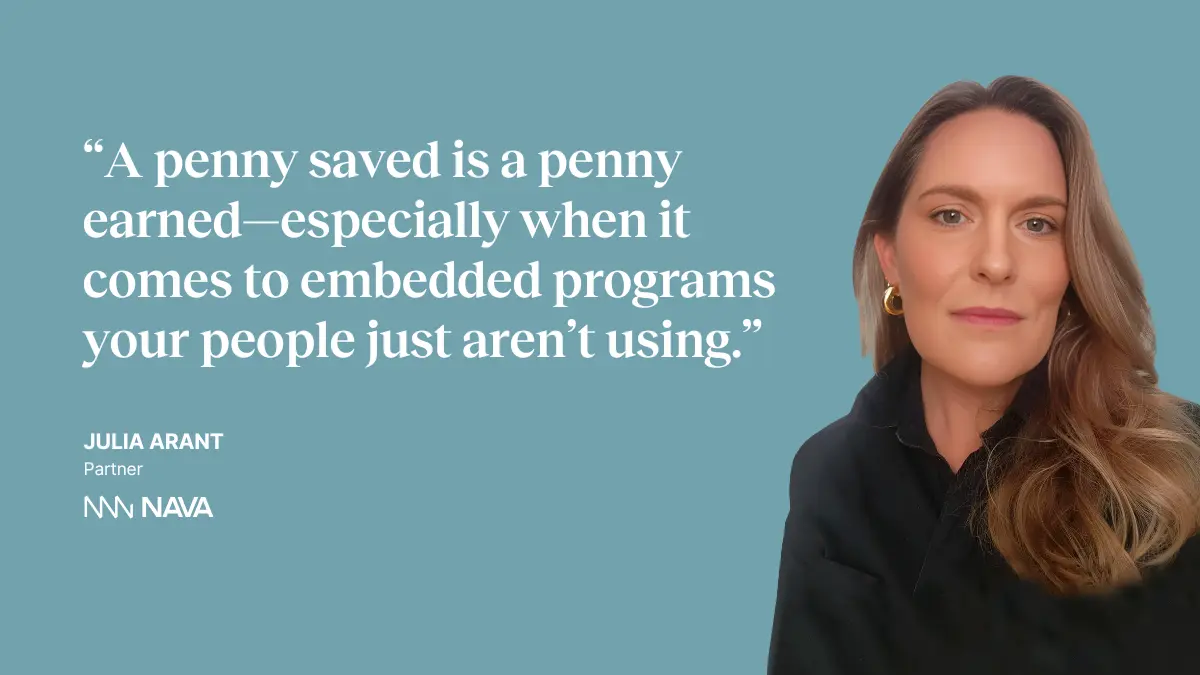How to offer great benefits on a budget: 21 strategies every nonprofit should know

Nonprofit benefits don’t have to mean choosing between impact and affordability. This guide breaks down cost-saving strategies—from auditing admin errors to rethinking plan design—that help you offer competitive, mission-aligned benefits on a limited budget. With real-world insights and actionable tips, it’s your roadmap to doing more with less, without compromising on care.
Nonprofits are built on purpose, not profit. But when it comes to employee benefits, the pressure to deliver competitive offerings with limited resources can be overwhelming.
How do you make benefits decisions that honor your mission, support your people, and stretch every dollar—all without overburdening a lean HR team?
That’s exactly what Nava Benefits explored in a recent webinar with Vivian Wan, CEO of Abode Services, and Julia Arant, a Partner at Nava Benefits who specializes in nonprofit clients. They shared practical strategies—many of them low-lift—that can help nonprofits strengthen their benefits offering without adding costs.
Why benefits are especially tough for nonprofits
Providing employee benefits is tough for any organization, but for nonprofits, the challenges are magnified. With tight budgets, small HR teams, and a mission-first mindset, nonprofits must balance care for their people with accountability to funders. Here are some of the most common hurdles they face when managing benefits programs:
- Unpredictable funding: Grants and donations can make it hard to plan for long-term benefits costs or absorb premium increases.
- Competing with government and private employers: It’s tough to match the rich benefits and compensation offered elsewhere.
- Lean HR teams: Small teams often lack the time or tools to manage benefits strategy, audits, and communications effectively.
- Limited data access: Without claims data or modeling tools, it’s difficult to evaluate or optimize plan design.
- Diverse employee needs: Field staff, part-timers, and administrators may need different support, but one-size-fits-all plans often fall short.
- Funders may undervalue benefits: Benefits rarely get attention in grant budgets, even though they’re key to retention and employee well-being.
So where do you start?
Despite these challenges, there are practical ways to strengthen your benefits offering without stretching your resources too thin. From unlocking underused tools to rethinking plan design, here are six low-lift, high-impact strategies to make your benefits program work harder for your people and your mission.
Leverage existing benefits or tools before adding more
If you’re like most nonprofits, you’re already investing heavily in employee benefits, but your staff may not know what’s available, how to use it, or what it’s worth.
In fact, 41% of American workers say they don’t fully understand their benefits. That’s a missed opportunity for both engagement and cost containment.
Try this:
- Promote your embedded benefits. Most health plans already include mental health resources, wellness apps, smoking cessation programs, and discount platforms, but employees may be unaware.
- Use modern communication tactics. Tools like push notifications, benefit fairs, and mobile apps can increase engagement—especially among non-desk employees.
- Leverage broker and carrier perks. Your broker may offer compliance tools (like Mineral), mental health support (like Headway), or tech investment sponsorships. Ask what’s included so you don’t leave value on the table.
- Review broker compensation. A commission-based structure may incentivize higher premiums. Consider a per-employee-per-month (PEPM) model for better alignment.

Eliminate overspend and admin mistakes in your benefits program
Overspending doesn’t always show up as a budget line item. Sometimes, it hides in the gaps—an ineligible dependent still on the plan, a data feed error that quietly inflates costs, or a missing approval for supplemental coverage.
Studies show that 4–8% of dependents on employer benefit plans don’t actually meet eligibility requirements, costing organizations an estimated $3,000 to $4,500 per year for each one.
When you're offering rich contributions (especially for dependents), even a single enrollment error can add up quickly.
Here’s where to start:
- Audit dependent eligibility. If you’re paying for someone who shouldn’t be on the plan, that’s money out the door.
- Scrub enrollment data. Small errors in feeds between HR systems and carriers can lead to big billing issues.
- Use your broker as a data partner. A good broker doesn’t just quote plans—they actively monitor feeds, conduct audits, and help manage tech integrations.
- Enlist broker support for systems RFPs. The right partner can help you evaluate, negotiate, and implement new platforms, taking the lift off your HR team.
“When HR is buried in data cleanup, they’re not serving employees. We rely on our broker for audits, RFP support, and even tech negotiations.” —Vivian Wan
Align with what employees really want and need
Benefits decisions should be informed by real data, both about what employees value and what they actually understand.
According to MetLife, 7 in 10 employees say they’d feel more loyal to their employer if their benefits were tailored to fit their personal needs.
Too often, nonprofit leaders guess at what their teams need or rely on general-market benchmarks that don’t reflect their unique talent pool.
What to do:
- Run employee engagement surveys. This uncovers two things: what employees want, and where they’re confused or disengaged.
- Benchmark wisely. If your staff compares your benefits to government roles, don’t just benchmark against other nonprofits. Look at the full competitive landscape.
- Reallocate where needed. If a benefit is underutilized, consider redirecting those dollars to broader-impact programs, like lifestyle savings accounts or concierge support.

Explore flexible funding models and plan designs that save money safely
There’s a misconception that smarter plan design always means higher risk or more work. But there are many ways to tweak your funding strategy without adding complexity or compromising care.
Consider options like:
- HDHP + HSA + Indemnity Plan: A high-deductible health plan with HSA contributions (plus a low-cost indemnity plan for major events) gives employees coverage while reducing premiums.
- MERPs or HRAs: These can reimburse specific expenses while keeping liability low.
- ICHRAs: Especially helpful if you have employees in different regions or outside of HMO networks like Kaiser.
- Self-funded dental or vision: A great starting point for exploring self-funding in a low-risk way.
Be proactive, not reactive with a multi-year benefits roadmap
Too often, benefits strategy becomes reactive. Renewal season hits, and teams scramble to make decisions without enough time to model alternatives or communicate well with employees.
A multi-year approach allows you to explore new models, track claims data, and introduce changes gradually.
A forward-thinking strategy might include:
- Level-funding: Predictable monthly premiums with the possibility of refunding unused dollars.
- Captives and self-insurance: For larger nonprofits, these offer deeper control and flexibility.
- Predictive risk modeling: Even if you don’t have full claims data, your broker can use external tools to simulate what self-funding could look like.
“We start pre-renewal conversations right after open enrollment ends. That’s how we make bold decisions feel safe.” —Julia Arant
Help employees understand the value of their benefits
Benefits decisions—even small ones—can feel personal to employees. If you increase costs, change coverage, or shift contribution strategy, it’s crucial to explain why.
Transparency builds trust. Silence erodes it.
Tips for stronger communication:
- Share your values. If your plan prioritizes employees with children, say that. If you’re nudging spouses toward their own coverage, explain why.
- Highlight total compensation. Especially when pay is modest, show the full picture: medical, time off, wellness, retirement.
- Translate broker-speak into your culture. Your team should hear your voice in every communication—not just canned plan documents.
“We saw real frustration over a $13 premium increase, until we explained the logic behind our contribution model. That context changed everything.” —Vivian Wan
Your pre-renewal checklist: 5 smart moves to make now
If your renewal is on the horizon, these steps will help you get ahead.
- Promote what you already offer. Boost engagement with embedded benefits through better communication.
- Audit your systems and dependents. Identify and correct costly enrollment issues.
- Run surveys and benchmark strategically. Use data to inform, not guess, your benefits decisions.
- Explore flexible plan design options. Even a small change can yield significant savings.
- Hold your broker accountable. They should bring you strategy, not just renewals.
Rethink what’s possible
Nonprofits shouldn’t have to choose between their people and their mission. With the right strategies—and the right partners—you can create a benefits program that’s cost-conscious, competitive, and aligned with your values.
Ready to stretch your benefits budget while supporting your team? Talk to our nonprofit team.
Watch the full webinar
Want to dive deeper into the discussion? Watch the full recording here.





.png)
.webp)